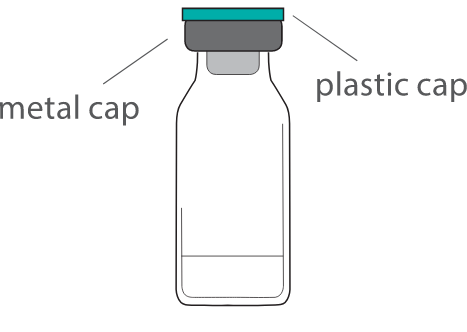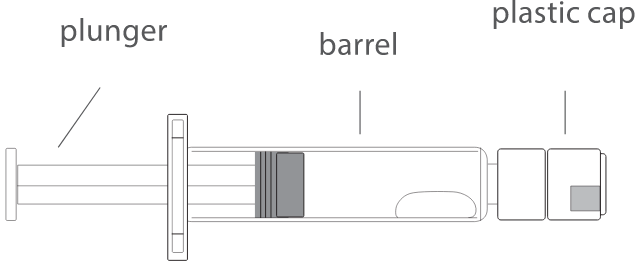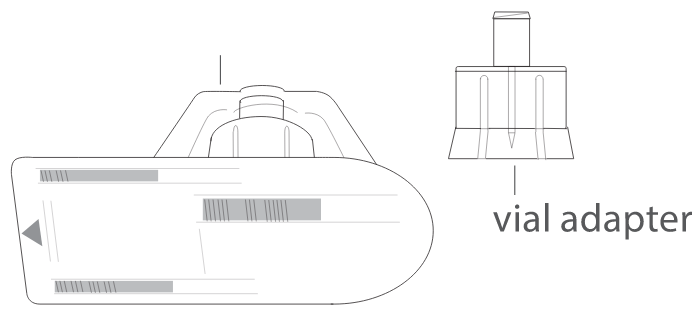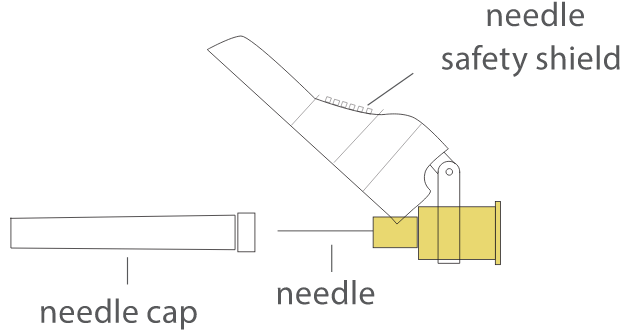After your last plasma exchange session, it’s recommended to continue daily CABLIVI for 30 days
When your doctor decides you can safely leave the hospital, you will need to continue to inject CABLIVI at home every day. Your doctor may decide you need to take CABLIVI for more than 30 days. This additional period may last up to 28 days.
Ask your doctor if you are being prescribed CABLIVI for the recommended time.
Your care team guides your treatment, but you should feel comfortable with the final decisions.
Comfort with taking CABLIVI at home is important to treatment success
Your CABLIVI injection can be done by you, a family member, or another caregiver. Before you leave the hospital, you and your doctor should decide who that person will be.
Your care team should teach you, your family, or your caregiver how to inject CABLIVI with confidence. Let your doctor know if you, your family, or your caregiver are not comfortable or if you have any questions.
HemAssist Sanofi Support offers one-on-one injection training—virtual or in person—7 days a week
It can be hard to remember everything your care team tells you in the hospital, which is why HemAssist provides a dedicated team to support your journey with CABLIVI and aTTP/iTTP. You’ll receive more than injection training, too, such as a comprehensive CABLIVI welcome kit, access to ongoing disease and treatment education, and financial support for eligible patients.
There are many resources to support you when it’s time to self-inject CABLIVI
Instructions can be found in a variety of formats so you can choose what works best for you. It’s important that you read through these instructions carefully before you inject CABLIVI and each time you get a refill. There may be new information.
It’s important to take CABLIVI exactly as prescribed—once a day—but mistakes can happen
If you miss a dose during plasma exchange (PEX)
-
Inject CABLIVI as soon as possible
If you miss a dose after you’ve stopped receiving PEX
-
Inject CABLIVI within 12 hours of your scheduled time
-
If it’s after 12 hours, skip the dose and inject CABLIVI at the next scheduled dose
If you take an incorrect dose
-
You should inject only 1 dose of CABLIVI at a time, as recommended by your doctor
-
If you accidentally use more than 1 dose of CABLIVI, don’t inject any more and call your doctor right away
Do not stop treatment early without talking with your doctor, even if you start to feel better.
Talk to your doctor before you stop taking CABLIVI. Stopping treatment early may result in another aTTP/iTTP episode.
The supplies you’ll receive to continue CABLIVI with confidence at home
What you’ll receive for self-injection with your CABLIVI prescription

A. One (1) vial
containing CABLIVI, a white powder for solution for injection

B. Two (2) alcohol swabs

C. One (1) prefilled syringe
containing 1 mL sterile water for injection, USP

D. One (1) sterile vial adapter

E. One (1) sterile needle
Additional supplies needed
-
FDA-cleared sharps disposal container (container for medical needles after they are used)
-
Cotton balls
Do's
-
Store CABLIVI in a refrigerator at 36°F to 46°F (2°C to 8°C) in its original packaging to protect it from light
-
You may also store unopened vials of CABLIVI at room temperature, up to 86°F (30°C), in the original carton for a single period of up to 2 months, but not beyond the expiration date
-
Use the mixed CABLIVI solution immediately after mixing. The mixed CABLIVI solution can be stored for up to 4 hours in the refrigerator at 36°F to 46°F (2°C to 8°C)
-
Keep the CABLIVI carton and supplies out of the reach of children
Dont's
-
Do not return CABLIVI to the refrigerator after storage at room temperature
-
Do not freeze CABLIVI
-
Do not use CABLIVI if you notice any particles in the solution or discoloration prior to administration
-
Do not use CABLIVI after the expiration date stated on the label and carton after “EXP.” CABLIVI expires on the last day of the month in the expiration date on the label and carton
-
Do not reuse any of the supplies
-
Do not throw away any medication, syringes, or needles with your household trash. Ask your pharmacist how to dispose of any CABLIVI you’re unable to use. Dispose of CABLIVI in a sharps container (container that is filled with medical needles after they are used). This will help protect you and the environment
Watch how to give yourself CABLIVI
How to Take CABLIVI® (caplacizumab-yhdp)
Playing this video will share cookies with YouTube.
Keep watching for CABLIVI Important Safety Information at the end of this video. Talk to your doctor about any questions you have about CABLIVI. Be sure that you read, understand, and follow the Instructions For Use before you inject CABLIVI and each time you get a refill. There may be new information. Your healthcare provider should show you how to prepare and inject CABLIVI properly before your first injection. Talk to your healthcare provider if you have any questions.
When it’s time for your injection, take CABLIVI out of the refrigerator. Never freeze your vials. If needed, CABLIVI may be stored at room temperature for up to 2 months. It may be helpful to write the date it was removed from the refrigerator in the space provided on the carton. Keep CABLIVI in the carton that it came in to protect it from light. For each injection, one carton of CABLIVI is needed.
Wash your hands with soap and water and place all components of the kit on a clean, flat surface. Check to make sure the carton contains all the items needed to prepare a dose of CABLIVI. Only use the supplies that are provided in the carton to prepare your prescribed dose. Do not reuse any of the supplies. Check the expiration date on the package and vial.
If the carton was stored in the refrigerator, allow the vial and the syringe to reach room temperature by holding in your hands for 10 seconds.
Remove the green plastic flip-off cap from the vial, and clean the rubber stopper using one of the alcohol pads. Allow to dry for a few seconds.
Take the packed vial adapter and remove the paper cover leaving the vial adapter in its packaging for now.
Place the adapter over the vial, while keeping the adapter in its plastic packaging.
Press down firmly until the adapter snaps into place, with the adapter spike pushing through the vial stopper.
Leave the adapter attached to the vial, still in its outer packaging.
Holding the syringe in one hand, break off the white cap by snapping at the perforation of the cap with your other hand. Then lay the syringe on a clean flat surface.
Remove the plastic packaging from the adapter by pressing the sides of the adapter packaging, and then lifting the packaging upwards. Be sure that the adapter does not detach from the vial. Hold the adapter with the attached vial. Place the tip of the syringe on the connector part of the vial adapter. Gently lock the syringe onto the vial by turning it clockwise until it cannot twist any further.
Place the vial upright on a flat surface. Slowly push the syringe plunger down until the syringe is empty.
Gently swirl the vial with connected syringe until the powder is dissolved. Allow the vial with connected syringe to stand on the flat surface for 2 minutes to allow the solution to completely dissolve.
Use the mixed CABLIVI solution immediately. The mixed CABLIVI solution can be stored for up to 4 hours in the refrigerator. Check the solution for particles, cloudiness, or clumps. All powder must be fully dissolved, and the solution must be clear. Use a new carton or call your healthcare provider if solution is not clear. Slowly press the syringe’s plunger fully down. Turn the whole—vial, adapter, and syringe—upside down. While keeping it vertical, slowly pull the plunger to transfer all the solution into the syringe. Turn the whole—vial, adapter, and syringe—right-side up and place on the flat surface. Detach the filled syringe from the adapter by gently turning the syringe counterclockwise. Put the vial and the attached adapter into a sharps disposal container. Place the syringe on the clean flat surface.
Remove the needle from the package, and attach it to the syringe without removing the needle cap by turning clockwise until it cannot twist any further. Pull back the needle safety shield.
Use the second alcohol pad to clean the injection site on your abdomen. Avoid the 2-inch area around your belly button. Let your skin dry.
Carefully remove the needle protection cap from the needle. Hold the syringe at eye level with the needle pointing upwards to see if there are any air bubbles. Remove any air bubbles by tapping the side of the syringe with your finger until they rise towards the tip. Then, slowly push the plunger until a small amount of liquid drips out of the needle. Gently pinch the cleaned skin between your thumb and forefinger to make a fold. Hold the pinch during the entire injection. Insert the full length of the needle into the skin fold at a 45- to 90-degree angle and press the plunger down until all of the solution is gone. Pull out the needle at the same angle you inserted it.
Right after your injection, move the needle safety shield over the needle until it clicks into place. In case you are bleeding at the injection site, place a cotton ball over the skin right away. Press gently on the cotton ball until the bleeding has stopped. Put the syringe, needle, and vial with adapter in a sharps disposal container right away after use. If you do not have an FDA-cleared sharps disposal container, you may use a household container that meets specific requirements according to your community guidelines.
INDICATION AND IMPORTANT SAFETY INFORMATION
What is CABLIVI?
CABLIVI (caplacizumab-yhdp) is a prescription medicine used for the treatment of adults with acquired thrombotic thrombocytopenic purpura (aTTP), in combination with plasma exchange and immunosuppressive therapy.
Who should not take CABLIVI?
Do not take CABLIVI if you've had an allergic reaction to caplacizumab-yhdp or to any of the ingredients in CABLIVI.
What should I tell my healthcare team before starting CABLIVI?
Tell your doctor if you have a medical condition including if you have a bleeding disorder. Tell your doctor about any medicines you take, including medicines that increase your risk of bleeding such as anti-coagulants and anti-platelet agents.
Talk to your doctor before scheduling any surgery, medical or dental procedure.
What are the possible side effects of CABLIVI?
CABLIVI can cause severe bleeding. In clinical studies, severe bleeding adverse reactions of nosebleed, bleeding from the gums, bleeding in the stomach or intestines, and bleeding from the uterus were each reported in 1% of subjects. In the post-marketing setting, cases of life-threatening and fatal bleeding were reported in patients receiving CABLIVI. Contact your doctor immediately if symptoms of excessive bruising, excessive bleeding, or major bleeding occur. Signs and symptoms of bleeding include: pain, swelling or discomfort, prolonged bleeding from cuts, increased menstrual flow or vaginal bleeding, nosebleeds, bleeding of gums from brushing, unusual bleeding or bruising, red or dark brown urine, red or tar black stools, headache, dizziness, or weakness.
You may have a higher risk of bleeding if you have a bleeding disorder (i.e. hemophilia) or if you take other medicines that increase your risk of bleeding such as anti-coagulants and anti-platelet agents.
CABLIVI should be stopped for 7 days before surgery or any medical or dental procedure. Talk to your doctor before you stop taking CABLIVI.
The most common side effects include nosebleed, headache and bleeding gums.
Tell your doctor if you have any side effect that bothers you or that does not go away. These are not all the possible side effects of CABLIVI. Call your doctor for medical advice about side effects.
HemAssist is dedicated to your needs, from starting CABLIVI in the hospital to continuing at home
You can make the most of your treatment with CABLIVI
*aTTP is also known as iTTP. You and your healthcare team can use either term.
aTTP/iTTP=acquired/immune-mediated thrombotic thrombocytopenic purpura.
IMPORTANT SAFETY INFORMATION AND INDICATIONS
Who should not take CABLIVI?
Do not take CABLIVI if you’ve had an allergic reaction to caplacizumab-yhdp or to any of the ingredients in CABLIVI.
What should I tell my healthcare team before starting CABLIVI?
Tell your doctor if you have a medical condition including if you have a bleeding disorder. Tell your doctor about any medicines you take, including medicines that increase your risk of bleeding such as anti-coagulants and anti-platelet agents.
Talk to your doctor before scheduling any surgery, medical or dental procedure.
What are the possible side effects of CABLIVI?
CABLIVI can cause severe bleeding. In clinical studies, severe bleeding adverse reactions of nosebleed, bleeding from the gums, bleeding in the stomach or intestines, and bleeding from the uterus were each reported in 1% of subjects. In the post-marketing setting, cases of life-threatening and fatal bleeding were reported in patients receiving CABLIVI. Contact your doctor immediately if symptoms of excessive bruising, excessive bleeding, or major bleeding occur. Signs and symptoms of bleeding include: pain, swelling or discomfort, prolonged bleeding from cuts, increased menstrual flow or vaginal bleeding, nosebleeds, bleeding of gums from brushing, unusual bleeding or bruising, red or dark brown urine, red or tar black stools, headache, dizziness, or weakness.
You may have a higher risk of bleeding if you have a bleeding disorder (i.e. hemophilia) or if you take other medicines that increase your risk of bleeding such as anti-coagulants and anti-platelet agents.
CABLIVI should be stopped for 7 days before surgery or any medical or dental procedure. Talk to your doctor before you stop taking CABLIVI.
The most common side effects include nosebleed, headache and bleeding gums.
Tell your doctor if you have any side effect that bothers you or that does not go away. These are not all the possible side effects of CABLIVI. Call your doctor for medical advice about side effects.
What is CABLIVI?
CABLIVI (caplacizumab-yhdp) is a prescription medicine used for the treatment of adults with acquired thrombotic thrombocytopenic purpura (aTTP), in combination with plasma exchange and immunosuppressive therapy.
Please see full Prescribing Information.
Instructions For Use
Sharps Medical Waste Disposal (PDF)
Learn more about Sanofi’s commitment to fighting counterfeit drugs.
IMPORTANT SAFETY INFORMATION AND INDICATIONS
Who should not take CABLIVI?
Do not take CABLIVI if you’ve had an allergic reaction to caplacizumab-yhdp or to any of the ingredients in CABLIVI.
What should I tell my healthcare team before starting CABLIVI?
Tell your doctor if you have a medical condition including if you have a bleeding disorder. Tell your doctor about any medicines you take, including medicines that increase your risk of bleeding such as anti-coagulants and anti-platelet agents.
Talk to your doctor before scheduling any surgery, medical or dental procedure.
What are the possible side effects of CABLIVI?
CABLIVI can cause severe bleeding. In clinical studies, severe bleeding adverse reactions of nosebleed, bleeding from the gums, bleeding in the stomach or intestines, and bleeding from the uterus were each reported in 1% of subjects. In the post-marketing setting, cases of life-threatening and fatal bleeding were reported in patients receiving CABLIVI. Contact your doctor immediately if symptoms of excessive bruising, excessive bleeding, or major bleeding occur. Signs and symptoms of bleeding include: pain, swelling or discomfort, prolonged bleeding from cuts, increased menstrual flow or vaginal bleeding, nosebleeds, bleeding of gums from brushing, unusual bleeding or bruising, red or dark brown urine, red or tar black stools, headache, dizziness, or weakness.
You may have a higher risk of bleeding if you have a bleeding disorder (i.e. hemophilia) or if you take other medicines that increase your risk of bleeding such as anti-coagulants and anti-platelet agents.
CABLIVI should be stopped for 7 days before surgery or any medical or dental procedure. Talk to your doctor before you stop taking CABLIVI.
The most common side effects include nosebleed, headache and bleeding gums.
Tell your doctor if you have any side effect that bothers you or that does not go away. These are not all the possible side effects of CABLIVI. Call your doctor for medical advice about side effects.
What is CABLIVI?
CABLIVI (caplacizumab-yhdp) is a prescription medicine used for the treatment of adults with acquired thrombotic thrombocytopenic purpura (aTTP), in combination with plasma exchange and immunosuppressive therapy.
Please see full Prescribing Information.
Instructions For Use
Sharps Medical Waste Disposal (PDF)
Learn more about Sanofi’s commitment to fighting counterfeit drugs.
IMPORTANT SAFETY INFORMATION AND INDICATIONS
Who should not take CABLIVI?
Do not take CABLIVI if you’ve had an allergic reaction to caplacizumab-yhdp or to any of the ingredients in CABLIVI.
What should I tell my healthcare team before starting CABLIVI?
Tell your doctor if you have a medical condition including if you have a bleeding disorder. Tell your doctor about any medicines you take, including medicines that increase your risk of bleeding such as anti-coagulants and anti-platelet agents.
Talk to your doctor before scheduling any surgery, medical or dental procedure.
What are the possible side effects of CABLIVI?
CABLIVI can cause severe bleeding. In clinical studies, severe bleeding adverse reactions of nosebleed, bleeding from the gums, bleeding in the stomach or intestines, and bleeding from the uterus were each reported in 1% of subjects. In the post-marketing setting, cases of life-threatening and fatal bleeding were reported in patients receiving CABLIVI. Contact your doctor immediately if symptoms of excessive bruising, excessive bleeding, or major bleeding occur. Signs and symptoms of bleeding include: pain, swelling or discomfort, prolonged bleeding from cuts, increased menstrual flow or vaginal bleeding, nosebleeds, bleeding of gums from brushing, unusual bleeding or bruising, red or dark brown urine, red or tar black stools, headache, dizziness, or weakness.
You may have a higher risk of bleeding if you have a bleeding disorder (i.e. hemophilia) or if you take other medicines that increase your risk of bleeding such as anti-coagulants and anti-platelet agents.
CABLIVI should be stopped for 7 days before surgery or any medical or dental procedure. Talk to your doctor before you stop taking CABLIVI.
The most common side effects include nosebleed, headache and bleeding gums.
Tell your doctor if you have any side effect that bothers you or that does not go away. These are not all the possible side effects of CABLIVI. Call your doctor for medical advice about side effects.
What is CABLIVI?
CABLIVI (caplacizumab-yhdp) is a prescription medicine used for the treatment of adults with acquired thrombotic thrombocytopenic purpura (aTTP), in combination with plasma exchange and immunosuppressive therapy.
Please see full Prescribing Information.
Instructions For Use
Sharps Medical Waste Disposal (PDF)
Learn more about Sanofi’s commitment to fighting counterfeit drugs.




